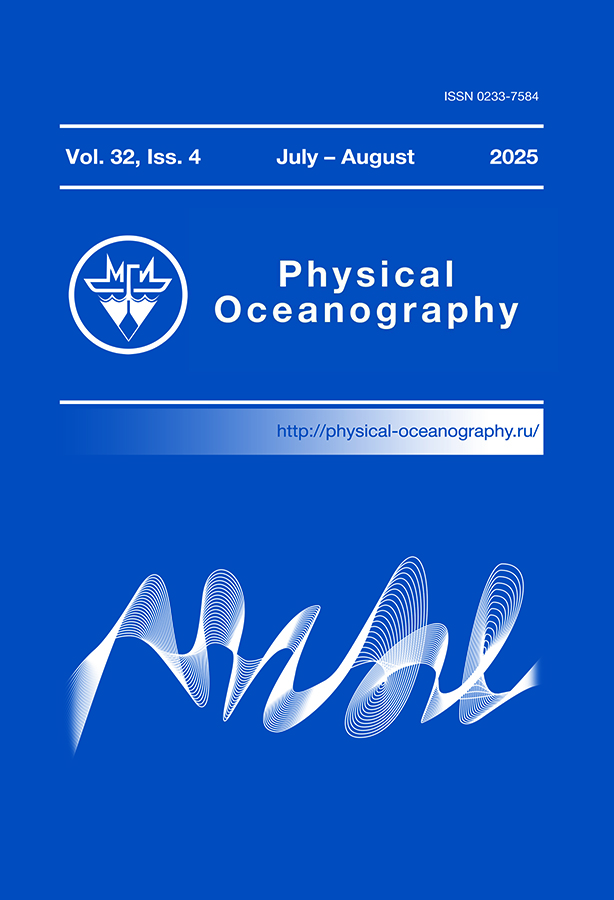Russian Federation
Russian Federation
Purpose. This study aims to analyze oxygen concentration data from the bottom waters of Amur Bay during the cold season and to identify the causes of its decrease in late February to March, when the bay remains ice-covered. Methods and Results. Variations in bottom water characteristics during the cold season were investigated in the area of summer hypoxia at a depth of 22 m (1 m above the seafloor) using the Water Quality Monitor autonomous bottom station (Wet Labs). Temperature, salinity (measured by conductivity), dissolved oxygen (DO), and chlorophyll a (measured by fluorescence) were recorded every 4 hours. Monitoring data from the cold period of 2013–2014 were compared with the data previously collected at the same station and location in summer 2011. The basic patterns of changes in oxygen content and the periods of dominance of production and organic matter mineralization in the bottom waters of Amur Bay during the cold season were identified. Conclusions. During the winter season, upwelling of the Japan Sea waters delivers nutrients to the bottom waters of Amur Bay. Enhanced vertical mixing, driven by low water column stability, supplies the euphotic layer with nutrients, enabling photosynthesis throughout the bay’s water column. Over four months in winter, the Amur Bay waters become supersaturated with oxygen relative to atmospheric levels. The onset of the summer monsoon (late February to early March) initiates the formation of summer hypoxia in the bottom waters of Amur Bay.
Japan Sea, Amur Bay, dissolved oxygen, hypoxia, upwelling, downwelling, nutrients, photosynthesis
1. Breitburg, D., Levin, L.A., Oschlies, A., Grégoire, M., Chavez, F.P., Conley, D.J., Garçon, V., Gilbert, D., Gutiérrez, D. [et al.], 2018. Declining Oxygen in the Global Ocean and Coastal Waters. Science, 359(6371), eaam7240. https://doi.org/10.1126/science.aam7240
2. Tishchenko, P.Ya., Tishchenko, P.P., Lobanov, V.B., Mikhaylik, T.A., Sergeev, A.F., Semkin, P.Yu. and Shvetsova, M.G., 2020. Impact of the Transboundary Razdolnaya and Tumannaya Rivers on Deoxygenation of the Peter the Great Bay (Sea of Japan). Estuarine, Coastal and Shelf Science, 239, 106731. https://doi.org/10.1016/j.ecss.2020.106731
3. Gomoyunov, K.A., 1926. A Hydrological Essay on the Amur Bay and the Suifun River. Proceedings of Far Eastern State University, Series 3, 1. Vladivostok: Far Eastern State University, 44 p. (in Russian).
4. Grigoriev, R.V. and Zuenko, Yu.I., 2005. Climatic Distribution of Water Temperature and Salinity in the Amur Bay (Japan Sea). Izvestiya TINRO, 143, pp. 179-188 (in Russian).
5. Tishchenko, P.Ya., Lobanov, V.B., Zvalinsky, V.I., Sergeev, A.F., Volkova, T.I., Koltunov, A.M., Mikhailik, T.A., Sagalaev, S.G., Tishchenko, P.P. [et al.], 2011. Seasonal Hypoxia in the Amur Bay (Japan Sea). Izvestiya TINRO, 165, pp. 136-157 (in Russian).
6. Tishchenko, P.P., Zvalinsky, V.I., Mikhaylik, T.A. and Tishchenko, P.Ya., 2021. Hypoxia in Peter the Great Bay. Izvestiya TINRO, 201(3), pp. 600-639. https://doi.org/10.26428/1606-9919-2021-201-600-639 (in Russian).
7. Gaiko, L.A., 2005. Peculiarities of Hydrometeorological Regime of the Coastal Zone in the Peter the Great Bay (Sea of Japan). Vladivostok: Dalnauka, 150 p. (in Russian).
8. Tishchenko, P., Tishchenko, P., Lobanov, V., Sergeev, A., Semkin, P. and Zvalinsky, V., 2016. Summertime in Situ Monitoring of Oxygen Depletion in Amursky Bay (Japan/East Sea). Continental Shelf Research, 118, pp. 77-87. https://doi.org/10.1016/j.csr.2016.02.014
9. Sorokin, Yu.I. and Konovalova, I.W., 1973. Production and Decomposition of Organic Matter in a Bay of the Japan Sea during the Winter Diatom Bloom. Limnology and Oceanography, 18(6), pp. 962-967. https://doi.org/10.4319/lo.1973.18.6.0962
10. Lazaryuk, A.Yu., Lobanov, V.B. and Ponomarev, V.I., 2013. Evolution of Thermohaline Structure in the Amurskiy Bay in a Cold Season. Vestnik of the Far East Branch of the Russian Academy of Sciences, 6(172), pp. 59-70 (in Russian).
11. Orrico, C.M., Moore, C., Romanko, D., Derr, A., Barnard, A.H., Janzen, C., Larson, N., Murphy, D., Johnson, R. [et al.], 2007. WQM: A New Integrated Water Quality Monitoring Package for Long-Term in-Situ Observation of Physical and Biogeochemical Parameters. In: IEEE, 2007. Proceedings of OCEANS 2007. Vancouver, BC, Canada, pp. 1-9. https://doi.org/10.1109/OCEANS.2007.4449418
12. Weiss, R.F., 1970. The Solubility of Nitrogen, Oxygen and Argon in Water and Seawater. Deep Sea Research and Oceanographic Abstracts, 17(4), pp. 721-735. https://doi.org/10.1016/0011-7471(70)90037-9
13. Tishchenko, P.Ya., Chichkin, R.V., Il’ina, E.M. and Wong, C.S., 2002. The Measurement of pH Values in Seawater Using a Cell without a Liquid Junction. Oceanology, 42(1), pp. 27-35.
14. Dickson, A.G. and Goyet, C., eds., 1994. Handbook of Methods for the Analysis of the Various Parameters of the Carbon Dioxide System in Sea Water. Version 2. OENL/CDIAC-74. DOE, 198 p.
15. Talley, L.D., Tishchenko, P., Luchin, V., Nedashkovskiy, A., Sagalaev, S., Kang, D.-J., Warner, M. and Min, D.-H., 2004. Atlas of Japan (East) Sea Hydrographic Properties in Summer, 1999. Progress in Oceanography, 61(2-4), pp. 277-348. https://doi.org/10.1016/j.pocean.2004.06.011
16. Burov, B.A., Lazaryuk, A.Y. and Lobanov, V.B., 2014. Study of the Heat Flux at the Water-Bottom Sediments in Amurskiy Bay in the Sea of Japan in the Winter Season. Oceanology, 54(6), pp. 695-704. https://doi.org/10.1134/S0001437014060022
17. Redfield, A.C., Ketchum, B.H. and Richards, F.A., 1963. The Influence of Organisms on the Composition of Seawater. In: M. N. Hill, ed., 1963. The Sea: Ideas and Observations on Progress in the Study of the Seas. New York: Interscience Publishers. Vol. 2, pp. 26-77.
18. Tishchenko, P.Ya., Borisenko, G.V., Barabanshchikov, Yu.A., Pavlova, G.Yu., Riumina, A.A., Sagalaev, S.G., Semkin, P.Yu., Tishchenko, P.P., Ulanova, O.A. [et al.], 2022. Estimation of Nutrient Fluxes on the Interface Bottom Water–Sediments in Shallow Bights of the Peter the Great Bay, Sea of Japan. Geochemistry International, 60(9), pp. 891-904. https://doi.org/10.1134/S0016702922090087
19. Vyshkvartsev, D.I. and Konovalova, G.V., 1979. On Mechanism of Winter Blooming of Microalgae in Peter the Great Bay (the Sea of Japan). Russian Journal of Marine Biology, (1), pp. 72-73 (in Russian).
20. Tishchenko, P.Ya., Barabanshchikov, Yu.A., Volkova, T.I., Marjash, A.A., Mikhailik, T.A., Pavlova, G.Yu., Sagalaev, S.G., Tishchenko, P.P., Khodorenko, N.D. [et al.], 2018. Diagenesis of Organic Matter in the Top Layer of the Sediments of the Peter the Great Bay in Hypoxia Locations. Geochemistry International, 56(2), pp. 171-181. https://doi.org/10.1134/S0016702918010093
21. Fredriksson, J.P., Attard, K., Stranne, C., Koszalka, I.M., Glud, R.N., Andersen, T.J., Humborg, C. and Brüchert, V., 2024. Hidden Seafloor Hypoxia in Coastal Waters. Limnology and Oceanography, 69(11), pp. 2489-2502. https://doi.org/10.1002/lno.12607













